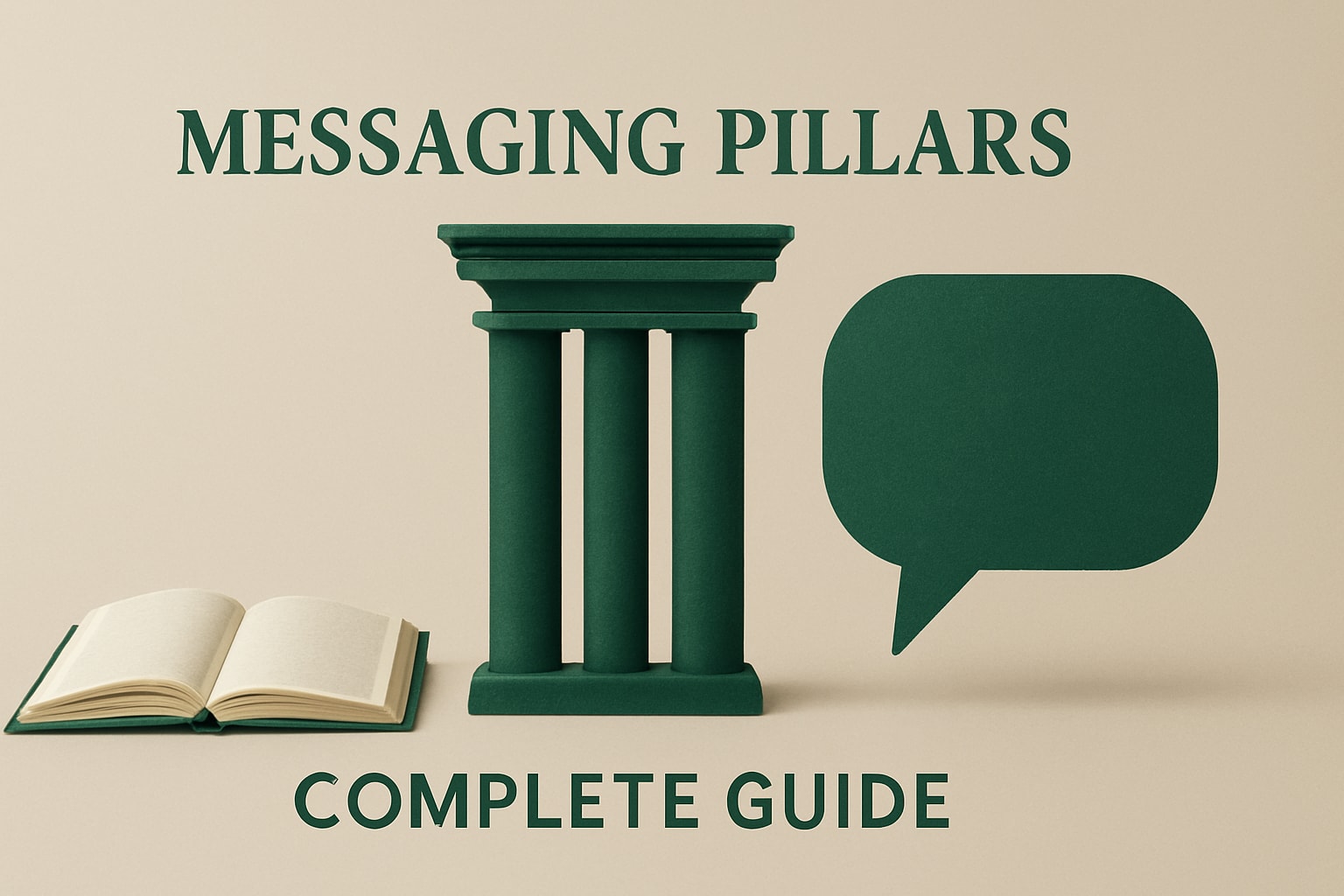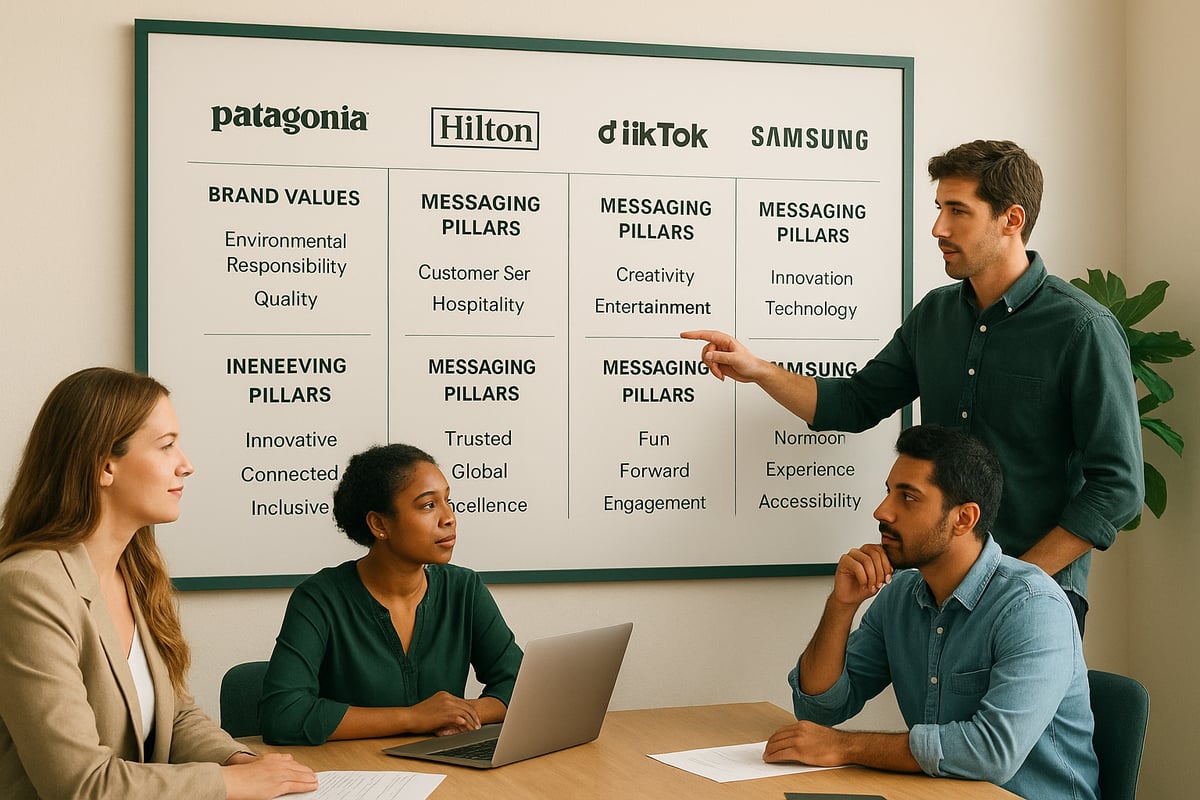
The Complete Guide to Messaging Pillars for 2025
Brand clarity is no longer optional in 2025. The marketplace is louder and faster than ever, making it easy for your message to get lost.
Many brands feel stuck, unable to communicate what truly sets them apart. If you’ve ever wondered why your story isn’t landing, you’re not alone.
This guide will show how messaging pillars are the foundation of clear, consistent communication. You’ll see what messaging pillars are, why they matter, how to define them, and how they help brands break through the noise.
Ready to transform the way your brand speaks and connects? Let’s get started.
What Are Messaging Pillars?
What makes a brand’s voice unforgettable in a crowded market? The answer often lies in messaging pillars. These are the core themes or values that guide every piece of communication your brand puts into the world. Think of messaging pillars as the backbone of your brand’s storytelling, ensuring that your message always feels true, no matter who is speaking or what channel you’re using.
At their core, messaging pillars articulate what your brand stands for, what you promise, and how you want to be perceived. They are not just buzzwords. Instead, they serve as a practical framework for shaping everything from ad copy to social media posts and internal memos. If you want a deeper dive into how these pillars keep brand storytelling cohesive, you can check out What Are Brand Messaging Pillars?.
It’s easy to confuse brand pillars with messaging pillars. While both are foundational, brand pillars typically describe the fundamental beliefs and values that guide a company’s culture and long-term vision. Messaging pillars, on the other hand, are focused on how those beliefs are communicated to the outside world.
Let’s draw a quick comparison:
The overlap is real, but the distinction matters. Brand pillars are your roots. Messaging pillars are the branches reaching out to connect with your audience.
Why does this matter? Messaging pillars provide a strategic “north star” for every department, from marketing to sales and even HR. With clear messaging pillars, teams can ensure that their tone, content, and campaigns remain cohesive and true to your brand’s identity. This alignment is essential for building trust, especially as the 2025 marketplace grows more competitive and noisy.
Here’s how messaging pillars support your brand:
- They unify marketing, sales, and internal communication, making sure everyone speaks with one voice.
- They clarify your value proposition, so customers instantly understand what makes you different.
- They lock in your positioning, helping you stand out against competitors.
Consider Patagonia’s sustainability pillar. This isn’t just a tagline. It’s a message that shows up in every campaign, product description, and customer interaction. That unwavering commitment to sustainability shapes how people feel about the brand, fueling both loyalty and advocacy.
Messaging pillars aren’t just for consumer brands. In 2025, both B2B and B2C companies need them to rise above the digital noise. Brands with clear messaging pillars achieve higher customer recall and loyalty, according to leading competitor insights.
The truth is, clarity wins. When your messaging pillars are clear and consistent, they become the compass for your brand’s journey—guiding every decision, campaign, and conversation.

Why Messaging Pillars Matter in 2025
The marketplace in 2025 is louder, more crowded, and moving faster than ever. Every brand is fighting for attention, yet consumers are tuning out generic messages. In this environment, messaging pillars are not just helpful, they are essential.
Messaging pillars provide a steady foundation when market noise threatens to drown out your brand’s voice. They help your business cut through the clutter by clarifying what you stand for. With messaging pillars in place, you can build real emotional connections and show authenticity, two qualities modern consumers actively seek. People are more likely to trust and remember a brand that communicates with clarity and purpose.
Consistent messaging across every channel is no longer optional. From social media and ads to your website and internal emails, messaging pillars ensure your story stays the same wherever it is told. This consistency is what drives lasting brand awareness, trust, and loyalty. According to competitor data, brands with consistent messaging see up to 23% higher revenue compared to those with scattered, unfocused communication.
Messaging pillars do more than guide marketing. They influence product decisions, shape company culture, and inform leadership communication. For example, Hilton’s hospitality, integrity, and leadership pillars are more than just words. These values shape how guests are treated and how employees interact every day. The result is a brand experience that feels unified and intentional at every touchpoint.
If you skip defining clear messaging pillars, the risks are real:
- Customers get confused about what you offer or why you matter.
- Your team struggles to create aligned content.
- Competitors with stronger messaging win mindshare.
- Opportunities for loyalty and advocacy slip away.
The power of messaging pillars lies in their ability to unify your brand’s voice. They act as a compass, helping you stay true to your values even as the market shifts. If you want practical steps to build this foundation, resources like the Brand Messaging Framework: The 8-Step Guide can help you get started and stay consistent.
In 2025, clarity wins. Messaging pillars are your north star, guiding every message, campaign, and conversation. When you invest in them, you give your brand the best chance to stand out, build trust, and grow.

Step-by-Step: How to Define Your Messaging Pillars
Defining your messaging pillars is not a task you rush. It’s a process of seeing your brand in the mirror and deciding what you want reflected back to the world. When you get this foundation right, every word, campaign, and conversation feels consistent and true. Let’s break down how to define your messaging pillars in a way that is practical, human, and ready for 2025.

1. Clarify Your Brand Purpose and Vision
Start with your “why.” Ask yourself, beyond making money, what is your brand here to do? This purpose is the wellspring from which your messaging pillars will flow. Dig into your founding story, or the spark that keeps your team going when things get tough.
Use your mission statement as an anchor. If you don’t have one, now is the time to write it. Ask your team: What change are we trying to make? What do we stand for, no matter what? These answers begin to form your messaging pillars.
For example, Apple’s “think different” wasn’t just a slogan. It captured their reason for being and set the stage for every message that followed. If you’re launching a new venture, consider how launching a new brand successfully is rooted in clear messaging pillars from day one.
Don’t be afraid to get personal. The most powerful messaging pillars often start with a founder’s vision, then become the north star for the whole team.
2. Gather Internal and External Insights
You can’t define messaging pillars in a vacuum. Listen to the people who matter most — your customers and your team. Start with social listening. What do people say about you online? What do reviews, mentions, and direct feedback reveal?
Next, involve your employees. They live your brand every day. Run workshops or simple surveys to surface the values and themes that feel most authentic. Ask: What stories do we tell each other? What gets celebrated here? The answers often hint at the bones of your messaging pillars.
Look for recurring patterns. If customers praise your transparency, or employees cite innovation, these are signals. Messaging pillars built from real insights will always resonate more deeply.
3. Analyze Competitors and Market Trends
No brand exists in isolation. Study competitors to see how they position themselves and which messaging pillars they lean on. For example, TikTok’s pillars of creativity and constant refresh shape every interaction on their platform.
Benchmark against industry leaders. What themes do they own? Where do you see white space — areas where your brand could stand out? Use market research, trend reports, and even customer interviews to spot opportunities.
The goal is not to copy, but to find gaps. Ask: What’s missing from the conversation? Where can our messaging pillars create real differentiation? By analyzing the landscape, you ensure your pillars feel relevant and future-ready.
4. Identify Core Values and Strengths
Now, turn inward. List the values that guide your decisions, even when no one is watching. These are the roots of your messaging pillars. Ask your team: What are we proud of? What do we never compromise on?
Prioritize values that resonate with both your customers and your internal culture. If there’s a disconnect, dig deeper. The best messaging pillars reflect who you are on your best day, not just who you wish to be.
Don’t try to be everything to everyone. Focus on a handful of core values that are authentic, actionable, and unique to your brand. These become the backbone of all communication.
5. Define and Articulate Each Pillar
With your core values in hand, craft each messaging pillar into a clear, concise statement. Each pillar should be actionable, not just aspirational. For example, instead of “innovation,” try “reimagining everyday technology for real people.”
Support each pillar with proof points or real-world examples. If sustainability is a pillar, point to your recycled packaging or ethical sourcing. This makes messaging pillars tangible and credible.
Keep language simple and direct. If your team can’t remember or explain a pillar, it’s too complex. Test your statements in conversation, emails, and even on your website to see if they land.
6. Test for Relevance and Alignment
Before rolling out your messaging pillars, test them. Share with trusted customers and your full team. Ask: Does this feel true? Is anything missing? Are these pillars bold enough to guide us into 2025?
Look for misalignment or confusion. If a pillar doesn’t fit across departments or customer journeys, refine it. Messaging pillars must be flexible enough for growth, yet specific enough to keep everyone on the same page.
Remember, feedback is a gift. The more voices you include, the more resilient your messaging pillars become.
7. Document and Refine
Finally, document your messaging pillars in a framework that’s easy to access and understand. This could be a simple chart, a one-pager, or a detailed playbook. The goal is to make the pillars visible and actionable for everyone.
As your brand grows or pivots, revisit your messaging pillars. For example, Savage X Fenty’s “fearlessness” and “inclusion” pillars have evolved as the brand’s audience and mission expanded. Regular check-ins ensure your pillars stay fresh and aligned with reality.
Think of messaging pillars as living guidelines, not museum pieces. The strongest brands keep refining and recommitting to their core messages as the world changes.
Real-World Examples of Effective Messaging Pillars
What does it look like when messaging pillars truly shape a brand? In 2025, the best brands anchor every interaction, campaign, and decision to clear messaging pillars. Let’s look at real-world examples where this clarity pays off.

Hilton: Hospitality, Integrity, Leadership
Hilton’s messaging pillars—hospitality, integrity, and leadership—are evident in everything from their advertising to their employee training. Guests experience the hospitality pillar through warm welcomes and tailored service. Internally, Hilton’s leadership messaging pillar guides how managers mentor teams and drive innovation. These pillars are not just words, they are embedded in Hilton’s culture and shape guest loyalty.
TikTok: Creativity, Constant Refresh
TikTok’s messaging pillars of creativity and constant refresh set the tone for both content creators and users. The brand encourages new ideas, playful experimentation, and quick pivots, making these pillars visible in campaigns and app updates. Every feature launch or trend spot reflects TikTok’s commitment to keeping the platform lively and original.
Savage X Fenty: Fearlessness, Inclusion
Savage X Fenty stands out by living its messaging pillars of fearlessness and inclusion. Every campaign is a celebration of diversity, with models of all backgrounds and body types. These pillars drive not just external branding but also product design and hiring practices. Customers feel invited and seen, which fuels brand advocacy.
Patagonia: Nature Protection, Innovation
Patagonia’s messaging pillars are clear: protect nature and drive innovation. Their activism, recycled materials, and transparent supply chain all reinforce these messages. Patagonia’s customers know what to expect—every touchpoint, from product tags to blog posts, circles back to these core pillars.
Samsung: Innovation, Social Betterment
Samsung’s messaging pillars—innovation and social betterment—guide everything from product launches to social initiatives. The company’s tech events, educational partnerships, and sustainability projects all reinforce a future-focused narrative. Customers and partners alike see these pillars in action.
When brands consistently apply messaging pillars, they build trust and stand out in a crowded market. Research shows that brands with clear, lived values see higher customer loyalty and advocacy. For founders and marketers, learning from these examples and balancing brand building and performance is essential for sustainable growth.
The lesson? Messaging pillars are not a one-time exercise. They are daily guideposts—living values that shape every story, campaign, and customer interaction.
Integrating Messaging Pillars Across Your Brand
Building messaging pillars is only the start. The real challenge lies in weaving them into every corner of your brand. When done right, messaging pillars become the threads that hold your identity together, guiding teams and shaping every interaction.
Embedding Pillars in Brand Guidelines
Start by documenting your messaging pillars clearly in brand guidelines. This gives everyone—from marketing to HR—a single source of truth. Strong guidelines include not just the pillars themselves, but also tone-of-voice examples and sample messaging for each pillar.
- Define each pillar with a short, actionable statement.
- Pair each with proof points or sample phrases.
- Update guidelines regularly to keep messaging pillars relevant.
If you want to dive deeper into maintaining consistency, explore An Integrated Approach for Improving Brand Consistency, which shares research-backed methods for aligning brand messaging across channels.
Guiding Content Creation and Campaigns
Messaging pillars are practical tools, not just theory. Use them as filters for every piece of content you create—ask if a campaign reflects at least one pillar before it goes live. This keeps your story focused and recognizable.
- Build content templates around each pillar.
- Batch campaigns by pillar for clarity.
- Use the keyword messaging pillars to approve or refine ideas.
When your content always circles back to these pillars, your brand voice grows stronger with each touchpoint.
Mapping Pillars to the Customer Journey
Map your messaging pillars to every stage of your customer’s journey. For example, Patagonia highlights its sustainability pillar even after purchase, building loyalty and advocacy.
- Awareness: Lead with your core values.
- Consideration: Share stories that bring each pillar to life.
- Purchase: Reinforce pillars at the decision moment.
- Loyalty: Keep pillars front and center in follow-up communications.
This alignment ensures your messaging pillars resonate from the first impression through to long-term relationships.
Training Teams and Partners
Consistency depends on people, not just documents. Train your teams and partners on the why behind your messaging pillars. Host workshops, use playbooks, and encourage feedback as your brand grows.
- Explain each pillar’s purpose in simple terms.
- Role-play scenarios to practice applying pillars in real situations.
- Update training as pillars evolve.
When everyone understands and believes in your messaging pillars, alignment becomes second nature.
Emerging Trends: The Future of Messaging Pillars in 2025 and Beyond
Imagine a world where AI and automation touch every interaction your brand has. In 2025, this is not science fiction. Messaging pillars become the compass, guiding machine-generated content so it still feels human, honest, and true to your core. Without clear messaging pillars, even the smartest AI can drift, creating noise instead of meaning. Tools now exist to map your pillars into content workflows and campaign engines, giving you consistency and control at scale. For a deeper dive into organizing your brand story for these new realities, see The Strategic Advantage of a Messaging House.
Personalization is everywhere. AI can now tailor every message, ad, or post to each customer. Yet, without strong messaging pillars, personalization risks losing the thread of your brand’s identity. The future demands pillars that are both flexible and unyielding, shaping content while letting people see themselves in your story. As automation scales, messaging pillars ensure your brand’s heart beats through every channel, even as the message adapts to each audience.
Transparency and ethics are no longer optional. Consumers in 2025 expect brands to do more than sell, they want to see real values in action. Messaging pillars must now address deeper issues: sustainability, inclusion, even mental health. Your pillars become a promise, not just to customers but to society. When your messaging pillars reflect what matters most, trust grows and loyalty follows.
Adaptation is key. As society changes, so must your messaging pillars. Look at how some brands update their pillars to stay relevant, responding to shifting cultural conversations or global events. Data backs this up: 70% of consumers want brands to take a stand on social issues. If you are defining your personal brand or leading a business, revisit your pillars often. The brands that thrive will be those who treat messaging pillars as living, breathing guides, always in tune with the world around them.
Common Challenges and Solutions When Implementing Messaging Pillars
Getting messaging pillars right is not always simple. Even with the best intentions, brands can trip over familiar obstacles. Here’s how to move from confusion to clarity.
Internal Misalignment and Lack of Buy-In
One major challenge with messaging pillars is internal misalignment. Teams may not agree on what the brand stands for, or why these pillars matter.
Solution: Involve cross-functional teams from the start. Invite input from leadership, marketing, sales, and even frontline staff. When everyone feels heard, buy-in grows. Connecting messaging pillars to the personal brand journeys of employees can also build alignment. For more on this, see defining your personal brand.
Pillars That Are Too Generic or Vague
Sometimes, messaging pillars sound like buzzwords. “Innovation,” “trust,” and “integrity” are nice ideals, but without substance, they fall flat.
Solution: Use specific, actionable language. Ground each pillar in real stories, proof points, or customer outcomes. Instead of “innovation,” try “pioneering new ways to connect people.” Test pillars with both your team and customers for resonance.
Inconsistent Application Across Channels
Even with clear messaging pillars, brands can stumble if they’re not applied consistently. One channel might sound authentic, while another feels off-brand.
Solution: Document pillars in brand guidelines. Provide examples, review content, and audit regularly. Train teams and partners to understand the “why” behind each pillar. Regular feedback loops help keep everyone on track.
Learning from Feedback and Iterating
Brands sometimes realize their messaging pillars miss the mark after launch. This happened to a tech company that, after customer feedback, refined its pillars to reflect real user needs. When brands listen, adapt, and revisit their messaging pillars annually, they see stronger results. In fact, brands that prioritize feedback and annual review outperform those that do not. For more on the power of narrative and adaptation, explore brand storytelling versus founder's story.
Iteration is not a weakness, but a sign that your messaging pillars are living tools for growth.
If you’ve made it this far, you know that building messaging pillars isn’t just another box to check—it’s a way to steady your voice and make your brand feel like home, to you and to everyone listening. This guide is here to help you get clear, but sometimes clarity calls for a little more conversation and care. If you’re ready for messaging that sounds like you—not just the you on paper, but the you that leads—let’s take the next step together.
Let’s shape a brand that sounds like you


